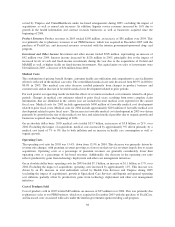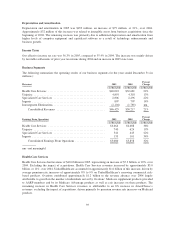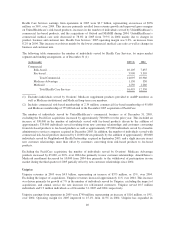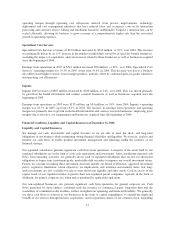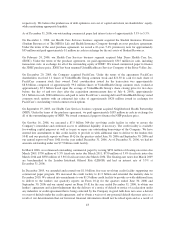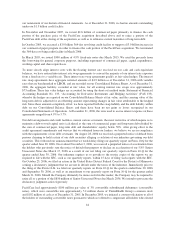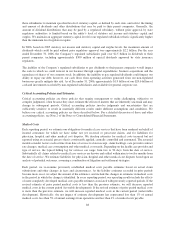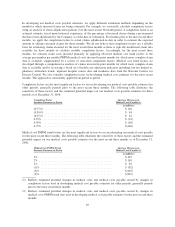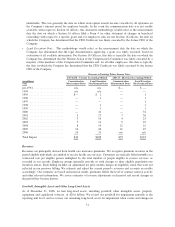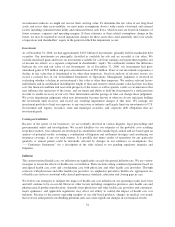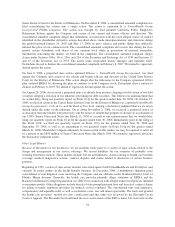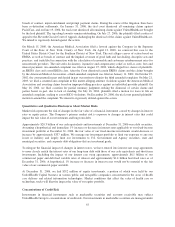United Healthcare 2006 Annual Report Download - page 49
Download and view the complete annual report
Please find page 49 of the 2006 United Healthcare annual report below. You can navigate through the pages in the report by either clicking on the pages listed below, or by using the keyword search tool below to find specific information within the annual report.During 2006, members were permitted to enroll or disenroll in a Medicare Part D plan until May 15, 2006. Once
enrolled, most members were allowed to switch plans once before May 15, 2006 (although low-income members
eligible for both Medicare and Medicaid are allowed to change plans monthly). Contracts are generally
non-cancelable by enrollees after May 15, 2006. After that date, enrollees may change plans once every year
between November 15 and December 31 to take effect January 1 of the following year.
As a result of the Medicare Part D benefit design, the Company incurs benefit costs unevenly during the annual
contract year. While the Company is responsible for a majority of a Medicare member’s drug costs up to $2,250,
the member is responsible for their drug costs from $2,250 up to $5,100 (at the Company’s discounted purchase
price). As such, the Company incurs disproportionately higher benefit claims in the first half of the contract year
as compared with last half of the contract year, when comparatively more members will be incurring claims
above the $2,250 initial coverage limit. Although the Company also incurs costs for individuals with annual
pharmacy claims in excess of $5,100, these costs represent a much smaller portion of total contract costs, and
will be incurred primarily in the second half of the year. The uneven timing of Medicare Part D pharmacy benefit
claims results in losses in the first half of year that entitle the Company to risk-share adjustment payments from
CMS. Accordingly, during the interim periods within the contract year we record a net risk-share receivable from
CMS in other current assets in the Consolidated Balance Sheets and a corresponding retrospective premium
adjustment in premium revenues in the Consolidated Statements of Operations. This represents the estimated
amount payable by CMS to the Company under the risk-share contract provisions if the program were terminated
based on estimated costs incurred through that interim period. Those losses reverse in the second half of the year
and final risk-share amounts due to or from CMS, if any, are settled approximately six months after the contract
year-end. The projected net risk-share payable to be paid to CMS as of December 31, 2006 was approximately
$350 million.
AARP
In January 1998, we entered into a ten-year contract with AARP to provide health insurance products and
services to members of AARP. These products and services are provided to supplement benefits covered under
traditional Medicare (Medicare Supplement insurance), hospital indemnity insurance, health insurance focused
on persons between 50 to 64 years of age, and other products. Under the terms of this Medicare Supplement
insurance contract, we are compensated for transaction processing and other services as well as for assuming
underwriting risk. We are also engaged in product development activities to complement the insurance offerings
under this program. Premium revenues from these AARP Supplemental Health Insurance offerings were
approximately $5.0 billion in 2006, $4.9 billion in 2005 and $4.5 billion in 2004.
The underwriting gains or losses related to the AARP Medicare Supplement Insurance business are directly
recorded as an increase or decrease to a rate stabilization fund (RSF). The primary components of the
underwriting results are premium revenue, medical costs, investment income, administrative expenses, member
services expenses, marketing expenses and premium taxes. Underwriting gains and losses are recorded as an
increase or decrease to the RSF and accrue to the overall benefit of the AARP policyholders, unless cumulative
net losses were to exceed the balance in the RSF. To the extent underwriting losses exceed the balance in the
RSF, we would have to fund the deficit. Any deficit we fund could be recovered by underwriting gains in future
periods of the contract. To date, we have not been required to fund any underwriting deficits. As further
described in Note 13 to the Consolidated Financial Statements, the RSF balance is reported in Other Policy
Liabilities in the accompanying Consolidated Balance Sheets. We believe the RSF balance at December 31, 2006
is currently sufficient to cover potential future underwriting and other risks associated with the contract.
Under a separate license agreement with AARP, we sell Medicare Prescription Drug benefit plans under the
AARP brand name. We assume all operational and underwriting risks and losses for these plans.
Regulatory Capital and Dividend Restrictions
We conduct a significant portion of our operations through subsidiaries that are subject to standards established
by the National Association of Insurance Commissioners (NAIC). These standards, among other things, require
47



